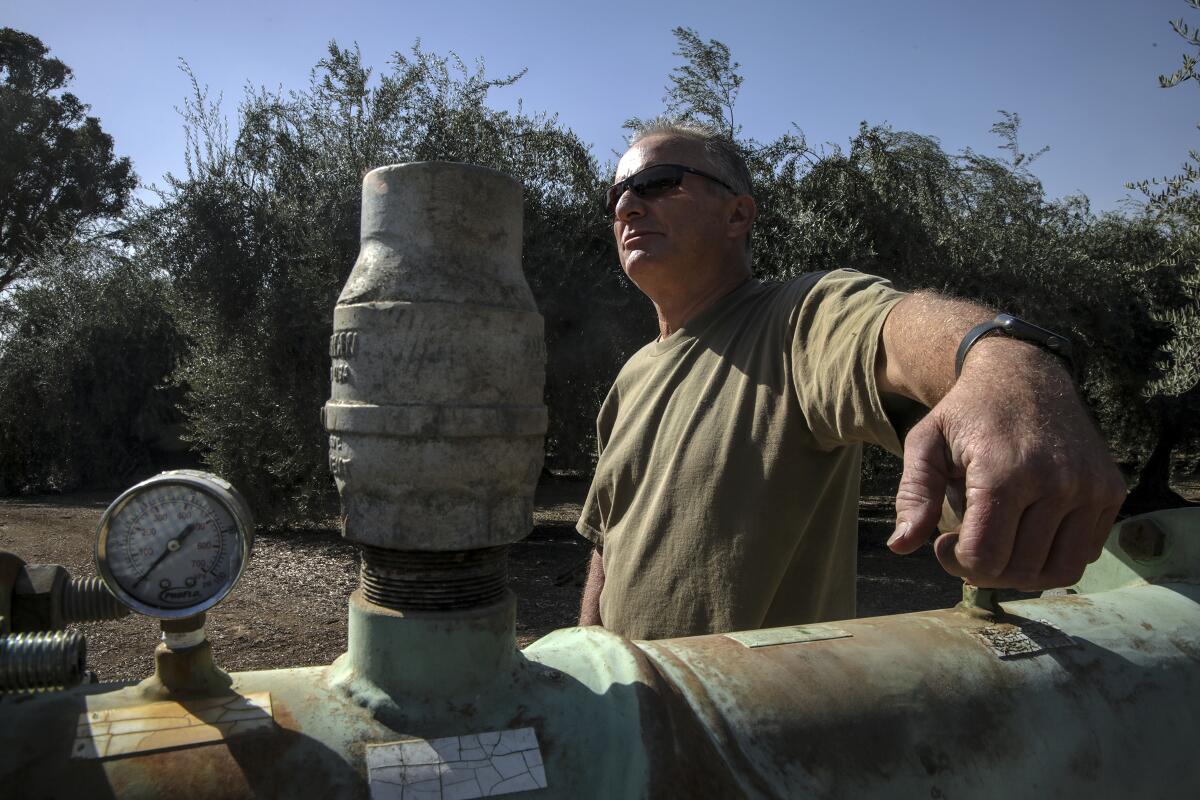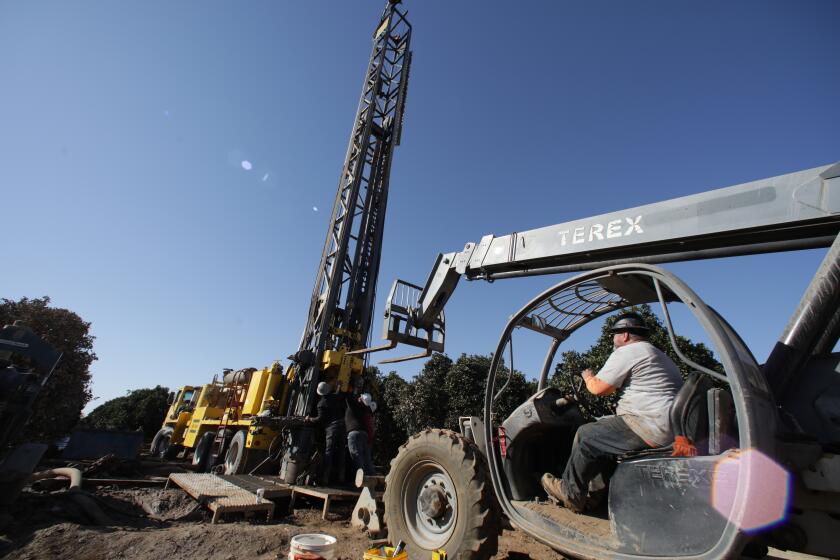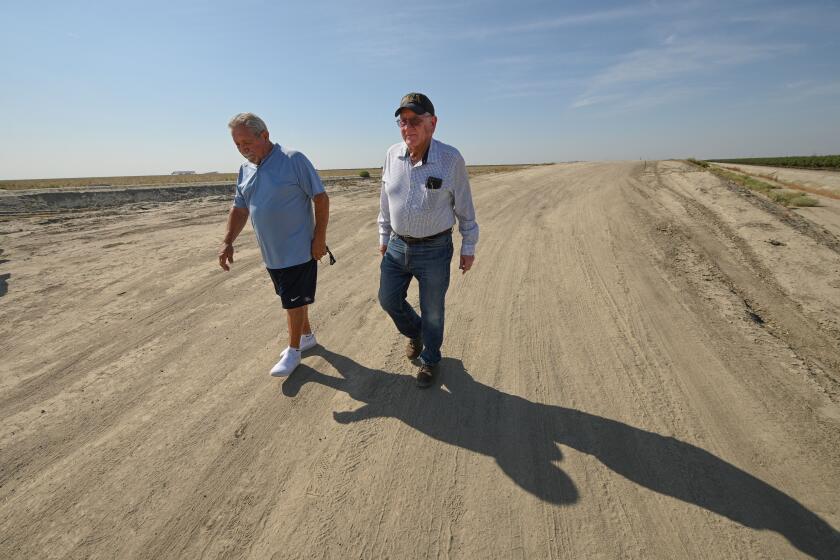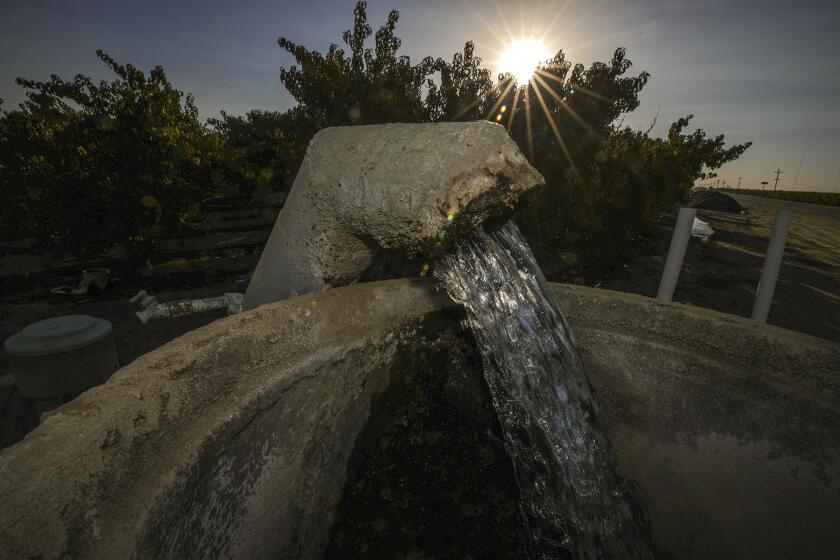Amid well-drilling and pumping, calls grow for stronger California water regulation

- Share via
In 2014, California adopted a landmark law aimed at combating excessive groundwater pumping, especially in farming areas of the San Joaquin Valley where many families were seeing their wells sputter and run dry.
More than eight years later, many local agencies are still working on long-term groundwater sustainability plans. Water levels have continued to decline, and in many areas household wells have continued to dry up — including some that have failed since torrential rains soaked the state in January.
Now, with more wells at risk of running dry, activists are urging the state to intervene in five Central Valley areas where they say plans are inadequate to combat chronic overpumping.
“At this point, we just don’t believe that the locals will actually take into consideration drinking water needs,” said Nataly Escobedo Garcia, a policy coordinator with the environmental justice group Leadership Counsel for Justice & Accountability.
California passed its landmark groundwater law in 2014. The goals of sustainable management remain a long way off.
“Wells are still continuing to go dry,” Escobedo Garcia said. “We ask that the state treats this as the crisis it is and acts in urgency.”
The push for stronger regulation comes as state lawmakers consider a bill that aims to clamp down on the frenzy of agricultural well-drilling in areas where groundwater supplies are considered to be in “critical overdraft.”
The bill, introduced by Assemblymember Steve Bennett (D-Ventura), would require so-called groundwater sustainability agencies, which were established under the 2014 law, to weigh in on well permit applications.
“There is a loophole in our system,” Bennett said, explaining that local groundwater agencies — which are responsible for managing their basins and reaching sustainable pumping levels by 2040 — currently do not have the authority to decide whether permits for new wells fit with their plans. Counties have traditionally signed off on permits without public input, a system Bennett called “over the counter” permits.
In recent years, while local agencies have prepared groundwater plans, thousands of new wells have been drilled on farmlands in the Central Valley.
“It’s essential that somebody has not just the authority but the responsibility to say these new wells are appropriate and consistent to go in,” Bennett said.
The bill, AB 1563, would make permanent requirements similar to those Gov. Gavin Newsom enacted as temporary drought measures in an executive order last year. The governor directed counties and cities to obtain written verification from a groundwater sustainability agency that issuing a well-drilling permit would be consistent with the local plan and wouldn’t “decrease the likelihood of achieving a sustainability goal for the basin.” The order also requires that before issuing a permit, the local agency must determine that the proposed well would be unlikely to interfere with nearby wells or cause sinking ground that would damage infrastructure.
Under Bennett’s legislation, those applying to put in small domestic wells would be exempt from the requirements. A permit for drilling a replacement well would be exempt if the original well is being shut down and the new well would pump the same amount of water.
The calls for more stringent measures have surfaced while state regulators are reviewing plans submitted by local agencies — one of the initial steps under the Sustainable Groundwater Management Act. The law requires local agencies in 21 critically overdrafted basins to achieve their sustainability goals by 2040.
Activists have called for state intervention in some of the 12 basins where the California Department of Water Resources has said submitted plans were incomplete and had deficiencies that needed to be corrected.
State water officials are expected to announce in the coming weeks whether they will accept plans developed for these 12 basins, require additional revisions, or deem them “inadequate” — a step that would trigger intervention by the State Water Resources Control Board.
Groundwater levels have declined across the Central Valley during the past three years of severe drought as supplies from rivers have diminished and as agriculture has depended more heavily on water pumped from wells.
More than 1,400 dry household wells were reported in 2022, the highest number since the state started tracking reports of well failures in 2013.
So far this year, 68 dry wells have been reported to the state.
Excessive groundwater pumping has long been depleting aquifers in California’s Central Valley. Now, scientists say the depletion is accelerating.
Escobedo Garcia and other environmental justice advocates have recently raised concerns about plans in five areas of the San Joaquin Valley — the Kaweah, Kings, Merced, Tule and Westside subbasins.
In letters to the Department of Water Resources, they said that current plans fail to address chronic lowering of groundwater levels and the associated problems — including degradation of water quality and sinking ground. They also argued that low-income communities and people of color have not been included in decision-making, and that their needs have not been prioritized.
When plans fail to protect residents’ drinking water, the activists said, the department should deem them inadequate and refer them to the State Water Board to be designated as “probationary basins.”
Under the law, the board has the authority to declare a groundwater basin “probationary” and to develop an interim plan for an area if the local agency fails to remedy an identified deficiency.
Escobedo Garcia told members of the State Water Board at a Feb. 7 meeting that despite the recent heavy rains, the storm runoff isn’t nearly enough to recoup losses in aquifers that have been declining for decades.
“This is unlikely to happen given the extreme shifts between dry and wet conditions we are experiencing due to climate change,” Escobedo Garcia told the board. “To make matters worse, the agriculture industry continues to drill new wells and overpump our limited groundwater, which leads to dry wells, water contamination, land subsidence and other harmful impacts.”
SGMA requires that local agencies consider domestic well owners and disadvantaged communities, she noted.
“We must ensure our basins are truly on a path to sustainability that protects all groundwater users,” Escobedo Garcia said. “As plans are currently written, we do not believe they will put us on that path.”
Warning of more dry wells and sinking ground, California officials tell local agencies their groundwater sustainability plans are flawed.
She cited an estimate that if overpumping is allowed to continue drawing down groundwater in the San Joaquin Valley, 20% to 49% of domestic wells could be “partially or fully dewatered” — affecting the drinking water supplies of up to 127,000 people.
“The plans need to be revised, and domestic wells cannot be sacrificed for agricultural use,” said Tien Tran, a policy advocate for the Community Water Center.
State officials plan to announce decisions by March 30 on whether they approve the plans with recommended corrective actions or declare them inadequate and ask the State Water Board to intervene, said Paul Gosselin, deputy director of the Department of Water Resources’ sustainable groundwater management office.
Gosselin said the board would have discretion in how to address inadequate plans. Under the law, he said, the aim is to “get the basin back to local control as quickly as possible.”
Gosselin said even in areas where the plans have flaws, local officials have been making “enormous progress,” with some starting to implement water allocations and pumping limits, as well as projects focused on replenishing groundwater.
“It’s real difficult, challenging work,” Gosselin said. “We might have been the last state in the West to have a statewide groundwater law in place, but I think what we’re finding is we have probably the best structured law in the country.”
Gosselin said it’s concerning that wells have continued running dry despite the recent wet weather, but he said it takes time for groundwater levels to rebound, and “the basins have a long way to go to recover.”
Amid a well-drilling frenzy in parts of California, new legislation would put local groundwater agencies in charge of permits.
To address overpumping in some areas, the Department of Water Resources recently started a program called LandFlex, which will provide $25 million in grants to local groundwater agencies for farmers who agree to limit water use. The program focuses on reducing pumping where nearby drinking water wells otherwise could be affected.
The program will provide financial incentives to farmers for each acre they enroll, and includes rules intended to ensure the participation of small and mid-sized farms.
A state website describing the program says limiting overpumping will mean “more water left in the ground and available for drinking water wells in California’s most vulnerable communities.”
Farmlands in the San Joaquin Valley produce a wide variety of fruits, nuts and cattle-feed crops. In the coming years, the requirements of the groundwater law are expected to force landowners to leave large portions of the valley’s farmland dry and fallow.
Researchers with the Public Policy Institute of California estimated in a recent report that by 2040, the average annual water supplies for agriculture could decrease by 20% — largely because of limits under the groundwater law but also because of climate change and other factors.
They estimated that in a “worst-case scenario,” nearly 900,000 acres of farmland would be fallowed and about 50,000 jobs would be lost. In some areas, they projected, more than half the irrigated farmland may eventually need to be left dry.
They said various measures could help soften the economic blow, including investments in boosting water supplies, localized buying and selling of water, and improvements in agricultural productivity.
“The valley can still thrive with less water,” said Alvar Escriva-Bou, a senior fellow at the institute.
The researchers said planning will be key in transitioning some farmland to other purposes, such as solar farms, crops that consume less water or restored habitat areas.
“There’s a lot of land that’s going to go out of production,” Escriva-Bou said. “If we want to do that in a careful way, to avoid more problems, we need to provide the right incentives.”











